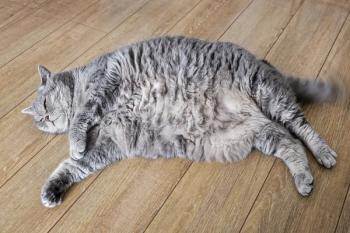
Nutritional diseases can still pose problems for companion avian species
Hemochromatosis results from excessive accumulation of iron in various body tissues.
Proper nutrition for companion avian species has long been and still is a central focus of avian veterinarians and aviculturists.
While nutrient requirements have been precisely defined for "economically important" species such as poultry, the body of knowledge for companion species backed by scientific exploration is lacking in comparison.
Suggested Reading
Quite honestly, the exact nutritional requirements for companion psittacine species are still not known. However, we can still make educated estimates of their nutritional needs based on an understanding of the biology/ecology of their free-ranging conspecifics, basic biomedical sciences, information available regarding poultry nutrition and the most current concepts of companion avian nutrition.
Currently, high quality, state-of-the-art commercial diets are available for various age groups, activity levels, reproductive status and even birds with specific health issues such as liver or kidney disease. Unfortunately, just like many humans, birds do not always have the ability to choose a balanced diet if offered unhealthy items such as sour cream and onion potato chips or red-velvet cake. As a result, diseases related to inadequate or inappropriate diets are arguably still common occurrences. Therefore, this article will review selected nutritional diseases in avian species including their clinical signs, diagnosis and treatment.
- Hypovitaminosis A
Vitamin A plays a crucial role in the health of avian species. It is necessary for vision, growth and differentiation of epithelial cells, immune function and normal function of secretory tissues.
Chronically low dietary vitamin A usually results in respiratory tract disease, poor feather quality and poor growth. Squamous metaplasia of epithelium within the oropharynx, choana and sinuses, gastrointestinal tract, urogenital tract and uropygial gland.
Hyperkeratosis of the feet and gout may also occur. Clinical signs include white plaques, abscesses or focal kertinaceous granulomas in the oropharynx, blunting of chaoanal papillae, nasal discharge, periorbital swelling, dyspnea, polyuria, polydipsia, poor feather quality, feather picking and anorexia. Diagnosis is usually based upon dietary history, physical examination and cytology of the respiratory tract.
Treatment consists of the removal of plaques or abscesses, appropriate antimicrobial therapy and supplementation of vitamin A both parenterally (maximum 20,000 IU/kg IM) (Aquasol A, AstroZeneca LP, Wilmington, DE) and orally as needed. However, be careful not to over-supplement with vitamin A.)
- Obesity
Obesity is another common nutritional disease of pet birds and is most often reported in budgerigars, Amazon parrots as well as rose-breasted and sulfur-crested cockatoos. Often, overindulgence in high-fat seed-based diets, or food items that are high in fat or energy (peanut butter, cheese or sweets) in conjunction with a sedentary lifestyle will lead to obesity.
Clinical signs include excessive deposition of fat or lipomas within the coelomic cavity as well as subcutaneous deposition along the neck, clavicular regions, breast area, body wall and abdomen.
Management of obesity requires either an increase in energy expenditure, a decrease in energy intake or both (most effective). Ideally, the bird should be placed on a pelleted diet (commercial diets with reduced calories are available) and given ample opportunity to increase its level of exercise.
Exercise may be gradually increased by allowing the bird more supervised activity out of the cage, providing toys that encourage playing as well as allowing the bird to fly so long as it is not dyspneic from its obesity. Thyroid hormone supplementation to reduce body fat is not recommended.
Lipomas may be carefully removed in those patients that do not respond to increased exercise or dietary modifications.
- Hepatic lipidosis
Hepatic lipidosis is due to excessive deposition and storage of fat in the liver and is more frequently seen in budgerigars, cockatiels, Amazon parrots and cockatoos. Inactivity, toxic insult and malnutrition are the most common causes of hepatic lipidosis.
Ultimately, hepatic lipidosis results from an inability of the liver to mobilize fats deposited in the liver from the diet or from fats that are synthesized from carbohydrate or protein in the liver. The latter is the more important as mobilization of this fat requires the production of lipoproteins as the form of fat carried from the liver. Inadequate calories form protein metabolism, methionine deficiency, biotin and choline deficiency may inhibit formation of these lipoproteins, thereby inhibiting mobilization of fat and resulting in hepatic lipidosis.
Clinical signs include anorexia, depression, diarrhea, biliverdinuria, obesity, poor feathering, overgrown beak and nails, pigment changes in feathers, abnormal molt, pruritis, dyspnea, abdominal enlargement, polyuria and polydipsia. Seizures, ataxia and muscle tremors may occur if the liver function is significantly impaired.
The diagnosis of liver disease is based upon physical examination, hematology, plasma biochemistries (elevated liver enzymes and bile acids) and radiology. Definitive diagnosis of hepatic lipidosis requires a liver biopsy. Every attempt should be made to determine the exact cause of hepatic lipidosis when it occurs.
Treatment requires placing the bird on a low-fat diet such as a commercial pelleted diet supplemented with small amounts of fresh fruits and vegetables. Excessive carbohydrates should be avoided. Patients that are depressed or exhibiting neurologic symptoms may benefit from the use of lactulose (0.3-0.7ml/kg q 8-12h) (Cephulac, Marion Merrell Dow, Inc., 9300 Ward Pky, Kansas City, MO 64114). Birds in critical condition should receive appropriate symptomatic therapy.
- Goiter
Goiter is reported most often in budgerigars and is characterized by regurgitation, dyspnea, increased respiratory noise ("chirp" or wheeze on expiration), crop distension and even circulatory compromise.
Dietary iodine deficiency leads to diffuse enlargement of the thyroid gland with excessive colloid. The enlarged gland may then displace the trachea, delay or prevent passage of food from the crop to the thoracic esophagus and stomach or even compress the heart and great vessels.
The diagnosis of goiter is based upon dietary history, clinical signs, physical examination, radiology and response to iodine supplementation. Affected birds may be treated with a 0.3% Lugol's solution in the drinking water (1 drop per 20 ml water) as the sole source of water. The water mixture is provided daily for the first week, three times weekly during the second week then once weekly. Patients that are dyspneic should receive supplemental oxygen as well as sodium iodide (20%) IM once daily for three to five days. If there is no response to therapy during that time the diagnosis should be re-evaluated. Placing the bird on a commercial formulated diet may prevent goiter.
- Hypocalcemic syndrome of African Grey parrots
The exact etiology of this syndrome in African Grey parrots is unknown, however, it is suspected that diets with an inappropriate Ca2+: P ratio (seed diets) or diets with marginal calcium, vitamin A, vitamin D3 or phosphorus levels may contribute to the development of this disease. Other proposed etiologies include decreased levels of PTH or an inability to effectively mobilize calcium from bone due to reduced osteoclast numbers in some African grey parrots.
The disease is typically seen in young African grey parrots (2-5 years old). Clinical signs include incoordination, weakness, falling from perches, seizures, collapse, opisthotonus and tetany. The diagnosis is based upon signalment, history, physical examination, plasma chemistry values (serum calcium levels less than 8.0 mg/dl) and response to parenteral calcium administration. Ionized calcium levels should be performed in order to better evaluate total body calcium. Demineralization of the skeleton to maintain normal calcium levels does not occur in this syndrome.
Parenteral administration of calcium gluconate (50-100 mg/kg IV slowly or IM diluted) (Vedco, Inc., 5503 Corporate Dr., St. Joseph, MO 64507 USA) is the treatment of choice and will often control seizures. Diazepam (0.5-1.0 mg/kg q 8-12 or as needed) (Valium, Roche Laboratories, 340 Kingsland St., Nutley, NJ 07110, USA) may also be required to control seizures. Long-term therapy involves placing the patient on a proper diet if the bird is not already on one and administration of calcium glubionate (25-150 mg/kg PO q 12h) (Neo-Calglucon, Rugby Laboratories, Inc., 2725 Northwoods Pkwy, Norcross, GA, USA) or calcium gluconate (1 ml/30ml drinking water) in addition to vitamin A/D3 supplementation. Vitamin A, D3 and E formulations should not be used in patients eating a formulated diet. Lifelong calcium and vitamin supplementation may be required. Follow-up examinations should evaluate plasma calcium concentrations to assess the effectiveness of treatment. Additional follow-ups after several months of therapy may also be needed.
- Osteomalacia and rickets
Metabolic bone diseases such as osteomalacia (thinning of cortices and demineralization of bone) and rickets (inadequate calcification of osteoid in growing birds) are the result of calcium, phosphorus and vitamin D3 deficiencies or an improper calcium:phosphorus in the diet.
Clinical signs of osteomalacia or rickets may include fractures, bending of long bones, skeletal deformities (spraddle-leg in chicks), polyuria and polydyspnea, beak malformations, reproductive problems (abnormal egg shape or difficulty passing eggs in females) and poor growth in young birds.
Diagnosis is based upon dietary history, clinical signs, physical examination, clinical pathology (especially total plasma calcium and ionized calcium levels) and demonstration of decreased bone density, fractures or skeletal malformations by radiographic evaluation. The patient should also be evaluated for underlying hepatic or renal disease.
Treatment involves correcting the underlying dietary deficiency by placing the patient on a commercial formulated diet, administration of oral or parenteral calcium and supplementation with other dietary sources of calcium such as dark, leafy green vegetables).
- Hemochromatosis (Iron Storage Disease)
Hemochromatosis results from the excessive accumulation of iron in various body tissues, but most frequently in the liver. Although, it may occur in Psittacines and other species, it is most commonly reported in toucans and mynah birds. The exact etiology is poorly understood; however, excessive iron (greater than 100 ppm) in the diet, one or more inherited metabolic defects, altered iron absorption from the intestines, concomitant disease, dietary changes or heavy metal toxicoses may contribute to the development of the disease.
Clinical signs most commonly include dyspnea, distension of the coelomic cavity due to ascites and weakness. Toucans may not show any clinical signs or may be depressed for a day prior to death while mynahs may exhibit weakness, coughing, dyspnea and distention of the coelomic cavity.
The diagnosis of hemochromatosis is based upon history, clinical signs, physical examination, radiographs and cytologic evaluation of the ascitic fluid. A definitive diagnosis requires biopsy and histopathologic examination of the liver.
Treatment of hemochromatosis requires aspiration of the ascitic fluid to relieve dyspnea, placing the bird on a commercially prepared low-iron diet and phlebotomy. Draw 1-2 mls of blood every 24 hours until clinical signs improve or the lower limit of the normal hematocrit is reached. The hematocrit should be measured with each phlebotomy. Blood is then drawn weekly at a rate of 1 percent of the bird's body weight in grams. Phlebotomies are discontinued and the patient is monitored when the hematocrit falls below normal. Total serum iron, albumin, hematocrit, repeated radiographs and body weight may be useful for monitoring treatment. Deferoximine (100 mg/kg subcutaneously q 24h) (Desferal, Ciba-Geigy Corp., 556 Morris Ave, Summit, NJ 07901, USA) in conjunction with a low-iron diet has been used to treat hemochromatosis.
Dr. Jones is asssistant professor of avian and zoological medicine at the University of Tennessee's College of Veterinary Medicine. He is a diplomate of the American Board of Veterinary Practitioners—Avian Specialty. Dr. Jones' clinical interests include raptor medicine, orthopedic and soft tissue surgery, avian nutrition and avian infectious diseases. He is also a master falconer with 15 years experience.
Disclosure: None
Newsletter
From exam room tips to practice management insights, get trusted veterinary news delivered straight to your inbox—subscribe to dvm360.




